.
Amathus (Modern Greek Αμαθούς) was one of the most ancient royal cities of Cyprus, on the southern coast in front of Agios Tychonas, about 24 miles west of Larnaka and 6 miles east of Limassol. Its ancient cult of Aphrodite was the most important in Cyprus, her homeland, after Paphos,[1] though the ruins of Amathus are less well-preserved than neighbouring Kourion.

Amathus was an ancient city of Cyprus, on the southern coast, about 24 miles west of Larnaka and 6 miles east of Limassol
It lies among sandy hills and sand-dunes, which perhaps explain its name in Greek (amathos, sand).
Pre-history and ancient era
The pre-history of Amathus mixes myth and archaeology.[2] Archaeology has detected human activity that is evident from the earliest Iron Age, ca 1100 BC,[3] The city's legendary founder was Cinyras, linked with the birth of Adonis, who called the city after his mother Amathous. According to a version of the Ariadne legend noted by Plutarch,[4] Theseus abandoned Ariadne at Amathousa, where she died giving birth to her child and was buried in a sacred tomb. According to Plutarch's source, Amathousians called the sacred grove where her shrine was situated the Wood of Aphrodite Ariadne.
It was said in antiquity that the people of Amathus were autochthonous, or "Pelasgian". Their non-Greek language is confirmed on the site by inscriptions in the Cypriot syllabary which, alone in the Aegean world, survived the Bronze Age collapse and continued to be used down to the fourth century BC. More purely Hellenic myth would have Amathus settled instead by one of the sons of Heracles, thus accounting for the fact that he was worshipped there.
Amathus was built on the coastal cliffs with a view of the sea and flourished at an early date, soon requiring several cemetaries. Greeks from Euboea left their pottery at Amathus from the tenth century. During the post-Phoenician era of the eighth century and palace was erected and a port was also constructed, which served the trade with the Greeks and the Levantines. A special burial ground for infants, a tophet served the culture of Phoenicians]]. For the Hellenes, high on the cliff a temple was built, which became a worship site devoted to Aphrodite, in her particular local presence as Aphrodite Amathousia. The excavators discovered the final stage of the Temple of Aphrodite, which dates approximately to the first century BC. According to the legend, it was where festive Adonia took place, in which athletes competed in hunting wild boars during sport competitions; they also competed in dancing and singing, all to the honour of Adonis.
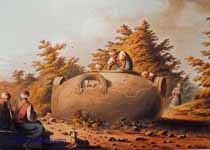
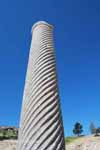
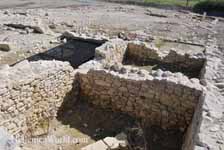
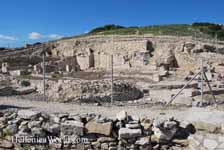
Amathus, Archaeological Site, Images





The earliest remains hitherto found on the site are tombs of the early Iron Age period of Graeco-Phoenician influences (1000-600 B.C.). Amathus is identified[5] with Kartihadasti (Phoenician "New-Town") in the Cypriote tribute-list of Esarhaddon of Assyria (668 B.C.).[6] It certainly maintained strong Phoenician sympathies, for it was its refusal to join the philhellene league of Onesilos of Salamis which provoked the revolt of Cyprus from Achaemenid Persia in 500-494 B.C,[7] when Amathus was besieged unsuccessfully and avenged itself by the capture and execution of Onesilos. Herodotus reports
"Because he had besieged them, the Amathusians cut off Onesilaos’ head and brought it to Amathous, where they hung it above the gates. As it hung there empty, a swarm of bees entered it and filled it with honeycomb.[8] When they sought advice about this event, an oracle told them to take the head down and bury it, and to make annual sacrifice to Onesilaos as a hero, saying that it would be better for them if they did this. The Amathusians did as they were told and still perform these rites in my day." (Histories 5.114)
About 385-380 B.C. the philhellene Evagoras of Salamis was similarly opposed by Amathus, in conjunction with Citium and Soli[9]; and even after Alexander the city resisted annexation, and was bound over to give hostages to Seleucus[10].
Its political importance now ended, but its temple of Adonis and Aphrodite (Venus Amathusia) remained famous in Roman time. The epithet Amathusia in Roman poetry often means little more than "Cypriote," attesting however the fame of the city.
The wealth of Amathus was derived partly from its grain[11] partly from its copper mines and sheep[12], of which traces can be seen inland.[13]
Amathus was a rich and densely populated kingdom with a flourishing agriculture and mines situated very close northeast Kalavasos. In the Roman era it became the capital of one of the four administrative regions of Cyprus.
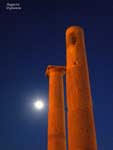






In Late Antiquity and the Middle Ages
Later, in the fourth century AD Amasus became the see of a Christian bishop and continued to flourish until the Byzantine period. In the late sixth century AD, Ayios Ioannis Eleimonas (Saint John Charitable), protector of the Knights of St. John, was born in Amathus.
Amathus still flourished and produced a distinguished patriarch of Alexandria (St. John the Merciful), as late as 606-616, and a ruined Byzantine church marks the site; but it declined and was already almost deserted when Richard Plantagenet won Cyprus by a victory there over Isaac Comnenus in 1191. The tombs were plundered and the stones from the beautiful edifices were brought to Limassol to be used for new constructions. Much later, in 1869, a great number of blocks of stone from Amathus were used for the construction of the Suez Canal.
In modern times
A new settlement close to Amathus but further inland, Agios Tychonas, is named after St. Tykhon, a bishop of Amathus. The site of the ruins is within the borders of this village, though the expansion of the Limassol tourist area has threatened the ruins (it is speculated that some of the hotels are on top of the Amathus necropolis).
The city had vanished, except fragments of wall and of a great stone cistern on the acropolis. A similar vessel was transported to the Musée du Louvre in 1867, a limestone dim, used for storing the must from the grapes, which dates to the sixth century BC. It is 1.85 m. high and weighs 14 tons. It was made from a single stone and has four curved handles bearing the head of a bull. In the 1870s Luigi Palma di Cesnola carried out excavations in the necropolis of Amathus, as elsewhere in Cyprus, enriching the early collections of the Metropolitan Museum of Art; some objects went to the British Museum. More modern archaeological joint Cypriote-French excavations started in 1980 and continue. The Acropolis, the Temple of Aphrodite, the market, the city’s walls, the basilica and the port have all been excavated. Further archaeological objects found during the excavations are conserved at the Cyprus Museum in Nicosia, as well as at the Limassol District Archaeological Museum.
In the market marble columns are decorated with spiral ornaments; there are huge paved precincts. At the coastal side of the city there are indications of an Early Christian basilica with mosaic floors decorated with semi-precious stones. Farther, near the terraced road leading to the Temple, situated on the top of the cliff, several houses built in a row dating to the Hellenistic period have been discovered. In the east and west extremes of the city the two acropoleis are situated, where a number of tombs have been found, many of which are intact.
Two small sanctuaries, with terracotta votive offerings of Graeco-Phoenician age, lie not far off, but the location of the great shrines of Adonis and Aphrodite have not been identified (M. Ohnefalsch-Richter, Kypros, i. ch.1).
Notes
1. ^ Walter Burkert, Greek Religion 1985, p. 153; J. Karageorghis, La grande déesse de Chypre et son culte, 1977.
2. ^ T. Petit, "Eteocypriot myth and Amathousian reality," JMA 12 (1999:108-20
3. ^ Aupert, Pierre (November 1997). "Amathus during the First Iron Age". Bulletin of the American Schools of Oriental Research 308: 19–25. doi:10.2307/1357406. http://www.jstor.org/stable/1357406. Retrieved on 2008-07-11. ; M. Iacovou, "Amathous, an early Iron Age polity in Cyprus: the chronology of its foundation", Report of the Department of Antiquities of Cyprus (2002) pp 101-22.
4. ^ Plutarch, vita of Theseus (20.3-.5), citing the lost text of an obscure Amathusan mythographer, Paeon.
5. ^ For eample by E. Oberhummer, Die Insel Cypern, i., 1902, pp. 13-14.
6. ^ But see Citium.
7. ^ Herodotus, v. 105
8. ^ The mytheme of bees in the carcase, familiar from the legend of Samson ( Judges 14:8, a lion's carcase) and the Greek myth of Aristaeus (a bullock carcase), and in Virgil's Georgics, is examined by Othniel Margalith, "Samson's Riddle and Samson's Magic Locks" Vetus Testamentum, 36.2 (1986:.
9. ^ Diodorus Siculus xiv. 98.
10. ^ Diodorus xix. 62.
11. ^ Strabo 340, quoting the mid-sixth century writer Hipponax.
12. ^ See Ovid, Metamorphoses x. 220, 227. 531.
13. ^ G. Mariti, i. 187; L. Ross, Inselreise, iv. 195; W. H. Engel, Kypros, i. 111 ff.
References
* This article incorporates text from the Encyclopædia Britannica, Eleventh Edition, a publication now in the public domain.
* Richard Stillwell, ed. Princeton Encyclopaedia of Classical Sites, 1976: "Amathous, Cyprus"
* Municipality of Limassol
Links
* Agias Tychonas: Amathus (English)

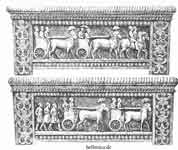
Ancient Amathus , http://www.sciencedaily.com/encyclopedia/amathus
Ancient Greek Cities and Places

| Ancient Greece
Science, Technology , Medicine , Warfare, , Biographies , Life , Cities/Places/Maps , Arts , Literature , Philosophy ,Olympics, Mythology , History , Images Medieval Greece / Byzantine Empire Science, Technology, Arts, , Warfare , Literature, Biographies, Icons, History Modern Greece Cities, Islands, Regions, Fauna/Flora ,Biographies , History , Warfare, Science/Technology, Literature, Music , Arts , Film/Actors , Sport , Fashion --- |
Retrieved from "http://en.wikipedia.org/"
All text is available under the terms of the GNU Free Documentation License

